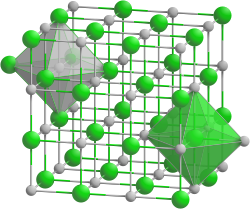Zirconium carbide
| Crystal structure | ||||||||||||||||
|---|---|---|---|---|---|---|---|---|---|---|---|---|---|---|---|---|

|
||||||||||||||||
| __ Zr 4+ __ C 4− | ||||||||||||||||
| General | ||||||||||||||||
| Surname | Zirconium carbide | |||||||||||||||
| other names |
|
|||||||||||||||
| Ratio formula | ZrC | |||||||||||||||
| Brief description |
odorless gray solid |
|||||||||||||||
| External identifiers / databases | ||||||||||||||||
|
||||||||||||||||
| properties | ||||||||||||||||
| Molar mass | 103.23 g mol −1 | |||||||||||||||
| Physical state |
firmly |
|||||||||||||||
| density |
6.73 g cm −3 |
|||||||||||||||
| Melting point |
3540 ° C |
|||||||||||||||
| boiling point |
5100 ° C |
|||||||||||||||
| solubility |
almost insoluble in water |
|||||||||||||||
| safety instructions | ||||||||||||||||
|
||||||||||||||||
| As far as possible and customary, SI units are used. Unless otherwise noted, the data given apply to standard conditions . | ||||||||||||||||
Zirconium carbide is an inorganic chemical compound from the group of carbides .
Extraction and presentation
Zirconium carbide can be prepared using the same processes as titanium carbide . It can do so through the carbothermal reduction of zirconium dioxide
or by synthesis from the elements at more than 2000 ° C. Since zirconium carbide is very sensitive to nitrogen , very pure argon must be used for high sintering . During the reactions it should be noted that carbon dissolves in zirconium carbide, whereby its melting point drops to 3100 ° C. When it cools down, the carbon precipitates again.
It can also be made from zirconium (IV) chloride .
Production by plasma CVD is also possible.
properties
Zirconium carbide is an odorless gray powder that is practically insoluble in water. It is insoluble in hydrochloric acid and sulfuric acid, but soluble in nitric acid . In air it is stable up to 800 ° C. Zirconium carbide has a crystal structure of the sodium chloride type with a considerable phase width (ZrC 0.99 -ZrC 0.55 ). It has a Vickers hardness of 25.5 GPa and a modulus of elasticity of 350 to 440 GPa. With halogens it forms tetrahalides at temperatures above 250 ° C. Like titanium carbide, it forms solid solutions with oxygen and nitrogen.
use
In contrast to titanium carbide, zirconium carbide, despite its good properties, is only used for coatings on fuels in atomic and fusion reactors. The reason may be its high price and the difficulty of removing impurities from it.
Individual evidence
- ↑ a b c d e f g h Data sheet Zirconium carbide, 99.5% (metals basis excluding Hf), Hf <200ppm from AlfaAesar, accessed on June 10, 2013 ( PDF )(JavaScript required) .
- ^ A b Dale L. Perry: Handbook of Inorganic Compounds, Second Edition . Taylor & Francis US, 2011, ISBN 1-4398-1462-7 , pp. 472 ( limited preview in Google Book search).
- ↑ a b c Georg Brauer (ed.), With the collaboration of Marianne Baudler a . a .: Handbook of Preparative Inorganic Chemistry. 3rd, revised edition. Volume II, Ferdinand Enke, Stuttgart 1978, ISBN 3-432-87813-3 , p. 1387.
- ^ A b c Hugh O. Pierson: Handbook of Chemical Vapor Deposition, 2nd Edition: Principles, Technology ... William Andrew, 1999, ISBN 0-08-094668-2 , pp. 256 ( limited preview in Google Book Search).
- ^ Hugh O. Pierson: Handbook of Refractory Carbides & Nitrides: Properties, Characteristics ... William Andrew, 1996, ISBN 0-08-094629-1 , pp. 73 ( limited preview in Google Book search).



